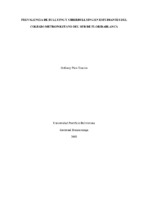| dc.contributor.advisor | Director. Redondo Pacheco, Jesús María | |
| dc.contributor.author | Pico Tenorio, Stefanny | |
| dc.coverage.temporal | 2019 | |
| dc.date.accessioned | 2020-10-28T19:37:07Z | |
| dc.date.available | 2020-10-28T19:37:07Z | |
| dc.date.issued | 2019-01 | |
| dc.identifier.uri | http://hdl.handle.net/20.500.11912/6241 | |
| dc.description | 79p.: (pdf); il; tablas; anexos. | spa |
| dc.description.abstract | El objetivo de este trabajo fue identificar la prevalencia de Bullying y ciberBullying en estudiantes de un colegio. La metodología utilizada fue de orden cuantitativo, no experimental, de tipo transeccional. Para ello, se evaluó a 263 estudiantes de secundaria, cuyas edades oscilaron entre los 10 y 20 años, se les aplicó el instrumento Ciberbullying: screening de acoso entre iguales (Garaigordobil, 2013). Los resultados arrojaron una prevalencia de Bullying del 87.8%, el 28.6% son víctimas, el 12.9% agresores y el 16.7% observadores. En cuanto a las conductas agresivas, la más predominante fueron las agresiones verbales, seguidas de las físicas, sociales y las psicológicas. Respecto al sexo se encontró diferencias en el rol de agresor superior en los hombres y en el rol de observadores se evidenció una mayor tendencia en las mujeres frente a los hombres. En cuanto a la edad, las víctimas mayormente son de 10 a 13 años comparado con los de 18-20 años, el rol de agresores, se evidencian mayores porcentajes entre los estudiantes de 16-17 años frente a los estudiantes de 12 a 20 años. En cuanto al rol del observador, no se encontraron diferencias significativas. La prevalencia del ciberBullying fue de un 76%, el 16.7% fueron cibervíctimas, el 8.1% ciberagresor y un 10% ciberobservador. En cuanto al sexo, se encontró diferencias en el rol de cibervíctima, siendo mayormente en los hombres que las mujeres, no se evidenció diferencias en los roles de ciberagresión y ciberobservador. Finalmente, con relación a la edad, existe un mayor cibervictimización en los estudiantes de 14 y 15 frente a los estudiantes de 10 a 13 años. El de ciberagresor se presentan mayores porcentajes en estudiantes de 16 y 17 años frente a los de 10 a 15 años. En cuanto al rol de ciberobservador no se encontraron diferencias significativas. | spa |
| dc.description.abstract | The purpose of this work was to identify the prevalence of bullying and cyberbullying in students of a school. The methodology used was quantitative, not experimental, of a transitional type. To this end, 263 high school students whose ages ranged between 10 and 20 years were evaluated using the Cyberbullying instrument: interrogation on the detection of bullying (Garaigordobil, 2013). The results showed a prevalence of Bullying of 87.8%, 28.6% were victims, 12.9% aggressors and 16.7% observers. As for the aggressive behaviors, the most frequent were the verbal aggressions, followed by the physical, social and psychological ones. With respect to sex, differences were found in the role of the superior aggressor in men and in the role of observers, a greater tendency was observed in women compared to men. In terms of age, the victims are mostly from 10 to 13 years compared to those from 18 to 20 years old, the role of the aggressors, the highest percentage of students from 16 to 17 years old compared to those of 12 to 20 years. Regarding the role of the observer, no significant differences were found. The prevalence of cyberbullying was 76%, 16.7% were cyber victims, 8.1% cybercriminal and 10% cyber observers. With respect to sex, differences were found in the role of the cyclitimate, mainly in men than in women, no differences were observed in the roles of cyber-aggression and cyber-observer. Finally, in relation to age, there is a greater degree of discrimination in students of 14 and 15 years compared to students from 10 to 13 years. Regarding the role of the cybercriminal, there are higher percentages in students of 16 and 17 years compared to those of 10 to 15 years. Regarding the role of the cyber-observer, no significant differences were found. | eng |
| dc.format.mimetype | application/pdf | |
| dc.language.iso | spa | |
| dc.publisher | Universidad Pontificia Bolivariana | spa |
| dc.rights | Attribution-NonCommercial-NoDerivatives 4.0 International | * |
| dc.rights.uri | http://creativecommons.org/licenses/by-nc-nd/4.0/ | * |
| dc.subject | Escuelas - Metropolitano del Sur de Floridablanca | spa |
| dc.subject | Bullying | spa |
| dc.subject | Ciberbullying | spa |
| dc.subject | Prevalencia | spa |
| dc.title | Prevalencia de Bullying y ciberBullying en estudiantes del Colegio Metropolitano del sur de Floridablanca | spa |
| dc.type | Trabajo de grado | spa |
| dc.publisher.department | Escuela de Ciencias Sociales | spa |
| dc.publisher.program | Psicología | spa |
| dc.type.hasVersion | publishedVersion | spa |
| dc.description.sectional | Bucaramanga | spa |
| dc.description.degreename | Psicólogo | spa |


